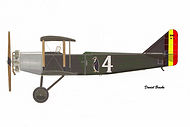Belgian Wings
Belgian Air Force, past and present.
The Aeronautical Reference Site - De Luchtvaart Referentie Site - Le site référence de l'Aéronautique
RSV 32/90 and variants

Single engine two-seat initial trainer aircraft
The RSV 32/90 (referring to 32 m² of wing surface and 90 hp engine) was the first complete Belgian aircraft design by the Renard, Stampe & Vertongen team. It was a very robust and forgiving aircraft which excellently fulfilled its role as basic pilot trainer. After the prototype RSV32/90 was demonstrated to King Albert on 23 April 1923 the Belgian Militair Vliegwezen/Aéronautique Militaire placed an initial order for 10 aircraft which were delivered between June and September 1924 (R-1 to R10), followed by 4 more aircraft delivered between March and April 1925 (R-11 to R-14). All of these trainers were powered by the 10-cylinder Anzani engine producing 90 hp. In the meantime, the RSV company had developed versions of their RSV 32 model powered by the Renard 100 hp engine (thus becoming RSV 90/100) and the Lorraine 5Pb engine of 110 hp (thus becoming RSV 32/110). In December 1928 five more trainers (R-15 to R-19) were delivered to the military, all powered by the Loraine engine (RSV 32/110). Two or three of these last batch of aircraft were equipped for blind flying training and had separate cockpits. Also, a number of existing military airframes were reengined with the Renard 100 hp bringing them up to RSV-32/100 standards. According to some sources an additional aircraft was also delivered to the military this being the RSV static test example most probably used as spare parts resource. The last RSV 32 trainers were withdrawn from military service between October 1935 and February 1936.















